Thesis topics/projects

What about starting a research project with me?
Here's a list of possible thesis topics, both at a bachelor (licenciatura) and master (maestria) level, but for a PhD as well (the latter need to be discussed in much deeper detail).
Feel free to contact me to ask more about any of those.
Radiative transfer in Active Galactic Nuclei: the silicate emission

The observed emission from the hot dust located in the molecular torus in Active Galactic Nuclei (AGN), is characterized by two spectral features in the Mid-Infrared (MIR) regime, centered at 9.7 and 18 micron. These can be observed both
as absorption and emission features, and their properties and origins, 9 years after they were observed for the first time, are still very poorly understood.
You will use the dust radiative transfer code SKIRT to create models of the infrared emission from AGNs, to investigate the nature and the characteristics of these features, to connect them with the chemical properties of the dust, and/or with its geometrical distribution. This work will be done in collaboration with Dr. Marko Stalevski, University of Belgrade (Serbia).

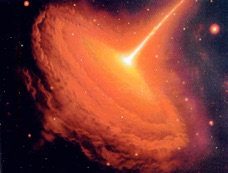
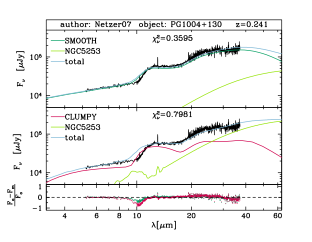


Upper panel: artist view of the dusty torus in an AGN.
Lower panel: example of an observed MIR spectrum reproduced with 2 different models.
The Herschel Reference Survey (HRS):
Properties of dust in nearby galaxies
The Herschel Reference Survey is a Herschel observational campaign designed to perform a benchmark study of dust in the nearby universe. The sample is volume-limited, and contains sources with distances between 15 and 25 Mpc and flux limits in the K band to minimize the selection effects associated with dust and with young high-mass stars and to introduce a selection in stellar mass. Initially conceived as a SPIRE-only survey (250, 350, 500 μm), it was lately complemented with PACS data (100-160 μm; Cortese et al. 2014).
You will start by reducing the PACS dataset using the latest software release, and then use these data, complemented with images at other wavelengths, to study the interplay between dust and stars.

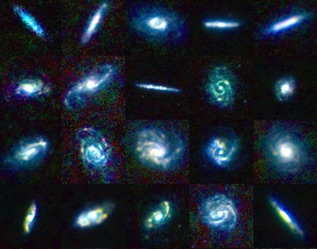
A portion of a collage of galaxies included in the Herschel Reference Survey, in false color to show different dust temperatures. (Blue is colder, and red is warmer). Credit: ESA/Herschel/HRS-SAG2 and HeViCS Key Programmes/L. Cortese (Swinburne University)
Infrared emission and stellar population synthesis:
development of the spectral fitting code SINOPSIS
SINOPSIS is a spectrophotometric fitting code which uses theoretical spectra of Simple Stellar Populations (SSP) to reproduce the most crucial features of observed optical spectra. In addition, photometric data can also be reproduced simultaneously with the spectrum.
SINOPSIS is currently limited to the stellar component emission; what is currently missing is the (thermal) emission component coming from the dust. Implementing the dust emission component must be done in such a way that dust heating, UV-optical extinction, and the characteristics of the stellar emission are consistent throughout the whole SED. Once upgraded, SINOPSIS will be able to deal both with observed broad-band spectra energy distribution, and with a combination of broad-band and spectroscopic data.

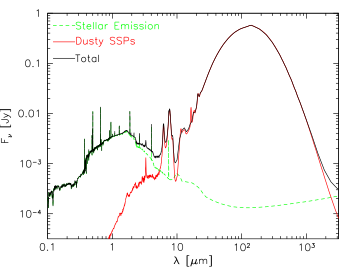
The stellar emission from SSP models (green) and dust thermal emission (red) are summed to yield the final model (black). Dust emission is not yet fully implemented in SINOPSIS, and can be done following several different approaches.
SKIRT MEETS SINOPSIS:
Checking the reliability of star formation history, dust attenuation and stellar ages from spectrophotometric models. Application to hydrodynamical simulations of galaxies.
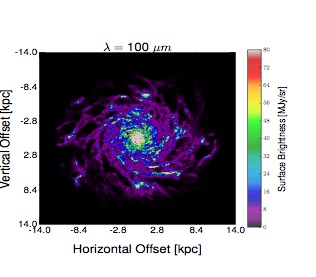
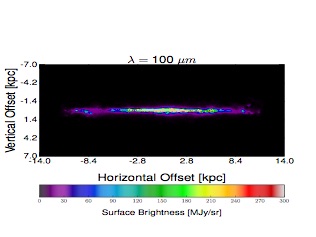
100 μm images of the “Eris galaxy” (Guedes et al. 2011, and see also Saftly et al. 2015). The upper panel shows the “edge-on” view, the lower panel the “face-on” view. Thanks to its high spatial resolution, it can be used as a study case to test the reliability of spectral synthesis and assess its drawbacks and limitations.


Spectrophotometric fitting codes, such as SINOPSIS, try to derive the most important properties of a galaxy, typically such as their stellar mass, their recent star formation history, and the stellar mass build up as a function of the cosmic time. To do so, they fit a model, usually made by summing spectra of Simple Stellar Populations of different ages and metallicities, to observed data, which could be an optical spectrum or/and a set of photometric datapoints.
Unfortunately, this method only deals with integrated data, i.e. data which sample the whole galaxy, and can be hence strongly biased towards the most luminous components. Integral field spectroscopy allows a step forward in this respect, but it cannot inevitably take into account projection effects -such as a complex 3D structure of a galaxy, and the relative geometry of stars and interstellar medium (dust in particular), which might have a strong influence on the overall emission.
How is this affecting the parameters derived from SED fitting? How important are the small scale structures and the mixing between star and dust? What is the effect of projection? You will analyze all these aspects by applying the spectrophotometric synthesis code SINOPSIS to a set of spectra of a simulated galaxies calculated with SKIRT to test the capabilities and the limits of the method.
Recent observations have found that dust in the molecular torus surrounding an AGN, might be geometrically distributed in dense, optically thick clumps, surrounded by a less dense, diffuse component. The prototypical of such 2-phase of models, is the one of Stalevski et al. (2012).
The work for this project will consist in completing the grid SEDs for different parameters for this model, and applying it to both validate the model and derive physical properties of AGN and QSOs. The sample of observed objects which is the most suited for this task is probably that of Hatziminaoglou et al. (2008,2009), which will have to be complemented with WISE data and, when possible, with Herschel and Spitzer IRS.
You will test the role of the different parameters in shaping the model emission, and check the role of the smooth component.
TWO-PHASE TORUS MODEL:
validation through SED-fitting


(Upper panel) Cut through the yz plane in the dust-density map of one of the two-phase torus models. (Lower panel) Map of the optical depth in the V band as it would be seen from the central source.